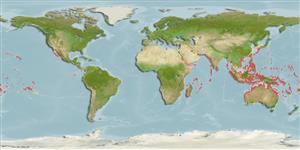Environment: milieu / climate zone / depth range / distribution range
Ökologie
seewasser demersal; tiefenbereich 4 - 20 m (Ref. 90102). Tropical
Indo-Pacific: from east Africa and Red Sea to western Australia, Taiwan and Ogasawara Is., Micronesia, the Hawaiian Is., the Cook Is., and the Pitcairn group.
Size / Gewicht / Alter
Maturity: Lm ? range ? - ? cm
Max length : 3.5 cm TL Männchen/unbestimmt; (Ref. 5467)
Rückenflossenstacheln (insgesamt) : 0; Rückenflossenweichstrahlen (insgesamt) : 22 - 25; Afterflossenstacheln: 0; Afterflossenweichstrahlen: 26 - 28. Body pale, with 8-12 narrow, short bars across dorsal surface (Ref. 5467). Dorsal saddles not reaching, even if present, a lateral band. Combined number of soft rays in dorsal and anal fins usually 44 to 51 (Ref 12874).
Benthic in surge-swept sand patches and shorelines (Ref. 1602, 58302). Found in sea bottoms with coarse sand and fine gravel 4-20 m deep (Ref. 90102). Occurs in small groups that bury themselves in coarse sand patches on reef corners subject to currents (Ref. 48636).
Life cycle and mating behavior
Maturities | Fortpflanzung | Spawnings | Egg(s) | Fecundities | Larven
Nelson, J.S., 1986. Creediidae. p. 736-737. In M.M. Smith and P.C. Heemstra (eds.) Smiths' sea fishes. Springer-Verlag, Berlin. (Ref. 5467)
IUCN Rote Liste Status (Ref. 130435)
Bedrohung für Menschen
Harmless
Nutzung durch Menschen
Tools
Zusatzinformationen
Download XML
Internet Quellen
Estimates based on models
Preferred temperature (Ref.
123201): 24.2 - 29.3, mean 28.2 °C (based on 2840 cells).
Phylogenetic diversity index (Ref.
82804): PD
50 = 0.5156 [Uniqueness, from 0.5 = low to 2.0 = high].
Bayesian length-weight: a=0.00389 (0.00180 - 0.00842), b=3.12 (2.94 - 3.30), in cm total length, based on all LWR estimates for this body shape (Ref.
93245).
Trophic level (Ref.
69278): 3.1 ±0.4 se; based on size and trophs of closest relatives
Fishing Vulnerability (Ref.
59153): Low vulnerability (10 of 100).
